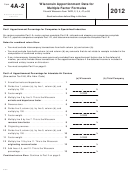Instructions For 2014 Form A-2: Wisconsin Apportionment Data For Multiple Factor Formulas
ADVERTISEMENT
Instructions for 2014 Form A-2:
Wisconsin Apportionment Data for Multiple Factor Formulas
Purpose of Form A-2
Corporations, partnerships, tax-option (S) corpora-
Part I: Apportionment Percentage for Companies
tions, and nonresident estates, trusts, and individuals
in Specialized Industries
that are engaged in a unitary business both in and
outside Wisconsin use Form A-2 if they are required
under the Wisconsin Administrative Code to appor-
Notes on Part I for Combined Return Filers
tion their income from the unitary business using
more than one factor.
If the taxpayer is a combined group member, its ap-
portionment factors must be adjusted to reflect its
The types of companies to which Form A-2 applies
status as a combined group member. The following
are:
adjustments must be made to the factors as other-
wise computed in Part I:
•
Direct air carriers (Part I-A)
•
Interstate Air Freight Forwarders Affiliated with a
Intercompany Transactions. Apportionment factors
Direct Air Carrier (Part I-B)
that represent intercompany sales must be excluded
•
from the amounts you enter in Part I. The following
Motor carriers (Part I-C)
factors represent intercompany sales:
•
Railroads and sleeping car companies (Part I-D)
•
•
Gross receipts of sales between combined group
Pipeline companies (Part I-E)
members.
•
Telecommunications companies (Part I-F)
•
Aircraft arrivals and departures, revenue tons, or
originating revenue attributable to flights per-
All other taxpayers required to use apportionment
formed for other combined group members.
must use Form A-1, Wisconsin Apportionment Data
•
for Single Factor Formulas.
Ton miles, revenue ton miles, or traffic units at-
tributable to transport performed for other com-
bined group members.
General Instructions for Combined Groups
The amounts in Part I must also exclude intercompa-
Each corporation in a combined group must complete
ny sales involving combined group members’ inter-
Form A-2, if applicable, to report the apportionment
ests in pass-through entities. See the instructions for
data for its own activities. The combined group then
Form A-1, line 11 for further details.
carries forward the amounts from each member’s
Form A-2 (or Form A-1, if applicable) to Form 6, Part
Sales Excluded from Combined Unitary Income. If
III, lines 1a and 1b, to determine the combined
you reported an amount on Form 6, Part II, line 6 for
group’s Wisconsin share of combined unitary income.
separately apportioned income, you must exclude
any apportionment factors attributable to those sales.
However, as a substitute for preparing multiple
See the instructions to Form N, Wisconsin Nonappor-
Forms A-2, a combined group may choose to prepare
tionable and Separately Apportioned Income, for fur-
a columnar spreadsheet with the rows representing
ther details on how to report and apportion separately
the appropriate lines of Form A-2 and each column
apportioned income.
representing a company in the combined group.
Intercompany Sales Previously Deferred.
All combined group members that file Form A-2 must
complete Part II.
If a combined group member made a sale to another
member of the combined group in a prior year and
Specific Instructions for Each Part
the gain or loss on the transaction was deferred un-
der the provisions in sec. 71.255(4)(g), Wis. Stats.,
These instructions are presented in the order the
the seller must include the gross receipts from the
parts appear on Form A-2:
sale (or the arrivals and departures, revenue tons,
originating revenue, ton miles, revenue ton miles, or
traffic units which generated those gross receipts, as
applicable) in its applicable apportionment factors in
IC-127
ADVERTISEMENT
0 votes
Related Articles
Related forms
Related Categories
Parent category: Financial
 1
1 2
2 3
3








